Remarks to The Regents
(Committee on Grounds & Buildings)
The following are the remarks prepared for the September 19, 2006 meeting of The Regents; the actual remarks may have differed slightly. Thumbnails of selected slides are included with the text below—click on the thumbnail to view a larger version of that slide; a complete copy of the slides is available in printable (PDF) format.
Wyatt R. Hume, Provost and Senior Vice President
Office of the President
The University of California System serves the people of California through the academic excellence of all its campuses. It is central to our nature and our values that each campus should be able to strive for the highest level of academic quality and transmit that quality to the people it serves.
My colleague, George Blumenthal, the acting chancellor of UC Santa Cruz, will be presenting one consequence of the academic planning process for that campus—the need for measured growth in enrollment. That growth will bring with it a continuing increase in the quality of the Santa Cruz campus and therefore increased value to the people that we serve.
Chancellor Blumenthal ...
George Blumenthal, Acting Chancellor
Santa Cruz campus
Thank you.
Chair Kozberg, members of Grounds & Buildings … thank you for the opportunity to present and seek approval of UC Santa Cruz’s 2005-2020 Long Range Development Plan and Environmental Impact report.
The process leading to these plans has gone on for more than three years under the supervision of four chancellors. The fundamental principle guiding our LRDP is that capital and land use strategies should promote the academic goals of the campus.
UCSC is now on a strong upward trajectory among the top tier of our nation’s universities. I am determined to continue that momentum. If we are to accommodate students beyond our present enrollment levels and to continue our momentum as a campus, this update to our 1988 LRDP is essential.
In this presentation, we will:
- Discuss the academic issues that motivate the LRDP.
- Review the campus’s record of achievement, which we will build upon to attain our academic vision.
- Demonstrate that the Santa Cruz campus has a proven record of site stewardship and responsible planning.
- Review the LRDP process, the EIR development, the recommended actions, and our record on mitigations—specifically, we do have a plan to address the impacts of growth on the environment and on the community.
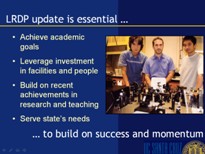 Let me first review the academic aspirations that underpin our plan and our recommendations today. UC Santa Cruz’s academic program is the heart of the Long Range Development Plan and this LRDP update is essential to:
Let me first review the academic aspirations that underpin our plan and our recommendations today. UC Santa Cruz’s academic program is the heart of the Long Range Development Plan and this LRDP update is essential to:
- Achieving our academic goals;
- Capitalizing on our existing investment in people and facilities;
- Building on the campus’ record of success; and
- Serving statewide needs.
Our 2020 plan is built on the success and momentum allowed under our last LRDP, which was completed in 1988 and provided an enrollment envelope of 15,000 students. That framework enabled the campus to evolve new programs—some of these such as genomics or computer game design were unforeseen even 15 years ago.
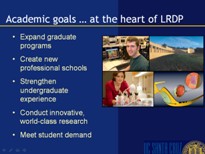 Building on our core and emerging strengths, the campus is poised, I believe, on the threshold of remarkable success. This LRDP provides the framework to achieve our campus goals. Therefore our academic planning is aimed at the following:
Building on our core and emerging strengths, the campus is poised, I believe, on the threshold of remarkable success. This LRDP provides the framework to achieve our campus goals. Therefore our academic planning is aimed at the following:
- It positions us to expand our graduate programs to 15% of overall enrollment;
- The plan allows us to introduce new professional programs and schools;
- It strengthens the undergraduate experience, which on our campus is distinctive, interdisciplinary, and personalized;
- The plan enhances our ability to create new knowledge by maintaining our research leadership in key disciplines; providing the opportunity to conduct innovative, world-class research in emerging fields; enhancing our ability to integrate research with the student learning experience; and
- It provides room to meet the needs of California’s student population.
I would like to review each of these five key academic goals—illustrating what we’ve accomplished during the timeframe defined by our 1988 LRDP; and how the campus has prepared for its next stage of development through 2020.
There is a broad consensus at UCSC regarding our first goal—the need to expand graduate education. Our goal is to increase the number of graduate students on campus to 15% of our enrollment. We want to maintain our momentum and fulfill the promise of newly created programs. We want to build on our achievements and develop new masters, doctoral, and professional degrees and, in doing so, better serve California.
Our focus on graduate education and research will also enhance the undergraduate experience at UCSC, which includes undergraduate research as a key element. Indeed, we find that the interaction of undergraduates and graduate students in classrooms and laboratories greatly benefits both groups. There has been steady growth in graduate enrollments, but graduate students now comprise only 9% of overall campus enrollment.
 The campus has more than doubled the number of research doctorate programs from 13 in 1988 to 28 today. As a result of these programs, the campus has more than doubled the number of PhD degrees it awards each year. In fact, in just the past five years, the campus has introduced 10 new exciting graduate programs.
The campus has more than doubled the number of research doctorate programs from 13 in 1988 to 28 today. As a result of these programs, the campus has more than doubled the number of PhD degrees it awards each year. In fact, in just the past five years, the campus has introduced 10 new exciting graduate programs.
 Our next anticipated program, an MS/PhD in “Statistics and Stochastic Modeling”, has been approved on campus and is awaiting systemwide approval.
Our next anticipated program, an MS/PhD in “Statistics and Stochastic Modeling”, has been approved on campus and is awaiting systemwide approval.
Work is also underway in support of our second academic goal—planning for new professional schools. Our strategy is to introduce focused programs that build upon campus disciplinary strengths—as well as regional needs and opportunities (Santa Cruz, Monterey, and Silicon Valley). We will build beyond our first example of this strategy: Jack Baskin School of Engineering which we designed as the engineering school of the 21st century. The campus is now determining the feasibility and need for a School of Management (primarily to be located in Silicon Valley), a School of Public Policy, and a School of Public Media.
 The third goal of our academic plan calls for us to strengthen our undergraduate programs—increasing the breadth of programs in order to continue what is a hallmark of UCSC. In fact, a key component of our land-use plan remains our innovative college system and residential learning experience, a physical feature that enables the campus to “feel small” while growing larger. Let me remind you that the core courses offered by our colleges provide a shared learning experience that has proven to be extremely valuable for freshman living in the same college.
The third goal of our academic plan calls for us to strengthen our undergraduate programs—increasing the breadth of programs in order to continue what is a hallmark of UCSC. In fact, a key component of our land-use plan remains our innovative college system and residential learning experience, a physical feature that enables the campus to “feel small” while growing larger. Let me remind you that the core courses offered by our colleges provide a shared learning experience that has proven to be extremely valuable for freshman living in the same college.
That distinctive undergraduate learning experience comprises several elements:
- Interdisciplinary, relevant curriculum—designed to build skills essential to 21st century issues—e.g., health sciences, global studies;
- Opportunities to participate in the research experience—by conducting research with both faculty and graduate students;
- Rigorous academic programs involving undergraduate research (e.g., as measured by percentage of our students who go on to pursue graduate degrees). Specifically, in a sample of all UC campuses and 60 AAU universities, UCSC ranked
- 15th for the percentage of its students whose bachelor's degrees led to doctorates;
- 2nd to only Berkeley among UC campuses in this percentage (and in the number of science & engineering doctorates);
- 1st among UC campuses for the fraction of non-science bachelor degree graduates going on to obtain doctorates.
The UC Santa Cruz faculty whose commitment to learning have created this quality undergraduate experience have also enabled the campus to make great strides toward our fourth academic goal—to expand our innovative, world-class research.
 One overall indicator of our faculty’s quality and innovation is the recent rise in external funding—over the past five years, awards have increased by 88% to $128 million. In the past year alone, research awards grew by 28%.
One overall indicator of our faculty’s quality and innovation is the recent rise in external funding—over the past five years, awards have increased by 88% to $128 million. In the past year alone, research awards grew by 28%.
The research is relevant, dynamic, strategic, involves partnerships, and has a global impact … and this research achievement is evident across each of the Santa Cruz disciplines.
Allow me to highlight two of the examples from this slide.
Our new Digital Arts and New Media is an innovative Masters of Fine Arts program that addresses the role of digital technology in the arts and explores the impact of digital arts on human culture.
 Now consider Genomics—by focusing on scientific interactions between computer science and molecular biology, David Haussler and his team have led the way in developing the path-breaking field of bioinformatics. Their algorithmic research allowed them to assemble the first public draft of the human genome, which they posted on the UCSC Website.
Now consider Genomics—by focusing on scientific interactions between computer science and molecular biology, David Haussler and his team have led the way in developing the path-breaking field of bioinformatics. Their algorithmic research allowed them to assemble the first public draft of the human genome, which they posted on the UCSC Website.
 In my own field of astronomy, the campus has taken an interdisciplinary approach leading to breakthroughs in a number of fields. The Center for Adaptive Optics, headquartered at UCSC, is a Science and Technology Center funded by the National Science Foundation. The center is involved in the design of a ground-based 30-meter telescope to be equipped with adaptive optics. This would be three times the diameter of the world’s largest telescope today. Once completed, the telescope will provide images that are more than ten times sharper than those of the Hubble Space telescope, so that it can observe planets around nearby stars and see more clearly what is happening close to the million-solar-mass black hole in the core of our own Milky Way galaxy.
In my own field of astronomy, the campus has taken an interdisciplinary approach leading to breakthroughs in a number of fields. The Center for Adaptive Optics, headquartered at UCSC, is a Science and Technology Center funded by the National Science Foundation. The center is involved in the design of a ground-based 30-meter telescope to be equipped with adaptive optics. This would be three times the diameter of the world’s largest telescope today. Once completed, the telescope will provide images that are more than ten times sharper than those of the Hubble Space telescope, so that it can observe planets around nearby stars and see more clearly what is happening close to the million-solar-mass black hole in the core of our own Milky Way galaxy.
But adaptive optics techniques have application in broader areas such as vision science and health care. Adaptive optics has made it possible to obtain images of the living human retina with unprecedented resolution, and researchers are exploring the potential of adaptive optics for looking at retinal diseases.
The campus’s deliberate investment in research infrastructure and in partnerships has resulted in two examples of the “big science” research partnerships that have benefited UC as a whole.
 UCSC is headquarters to UC Observatories, which is a managing partner (with Caltech) of the world's two largest ground-based optical and infrared telescopes at the Keck Observatory in Hawaii.
UCSC is headquarters to UC Observatories, which is a managing partner (with Caltech) of the world's two largest ground-based optical and infrared telescopes at the Keck Observatory in Hawaii.
The University Affiliated Research Center at the NASA Ames Research Center is part of our Silicon Valley Initiative. UCSC is managing a national research program valued at more than $330 million under an agreement with NASA. This 10-year contract is a first-of-its-kind for NASA. Although UCSC manages the program, it benefits all of UC.
But our impact is evident well beyond the sciences (and far beyond California).
UCSC's New Teacher Center is an example of research and service. Active in 31 states, it has dramatically increased teacher retention and boosted student achievement. It is now part of a $36 million program to provide mentors for all first-year teachers in the New York City public school system.
The relevance and global impact of our research contributions is at the core of our educational mission.
Finally, our fifth academic goal—meeting student demand—has been a key part of our planning.
 Since our last LRDP, our enrollment has increased from 9,000 to 15,000 students and student demand continues to grow. Freshman applications reflect this demand—more high school graduates want to come to UCSC than ever before. In fact, first-time freshman applications to UCSC were up almost 7% this year. We can no longer accommodate all UC eligible students wishing to attend UCSC.
Since our last LRDP, our enrollment has increased from 9,000 to 15,000 students and student demand continues to grow. Freshman applications reflect this demand—more high school graduates want to come to UCSC than ever before. In fact, first-time freshman applications to UCSC were up almost 7% this year. We can no longer accommodate all UC eligible students wishing to attend UCSC.
The number of students transferring from community colleges is an important part of our enrollment—making up 25% of entering students. The attractiveness of our campus at all levels—undergraduate through professional—is the result of our relevant academic programs, our integration the research mission of the University into learning, and UCSC’s excellent and diverse faculty and staff.
The campus aspires to build upon this record of being responsive to State demand for a UC-quality, relevant education. Our efforts to date have increased the popularity of the campus and we wish to make every effort to accommodate as much of that demand as is possible—consistent with sound planning and our pursuit of quality. This update to our LRDP enrollment envelope will enable these goals.
The framework for the LRDP update before you today grew out of a faculty-led academic vision committee in 2003 that emphasized the faculty’s pursuit of excellence in research and instruction. The committee analyzed four campus goals:
- Realizing the full potential of existing programs—including an increase in the number of our nationally ranked academic programs;
- Anticipating new academic programs;
- Accommodating graduate and undergraduate student enrollment demand.
- Reflecting the diversity of the State. The committee recognized that UC has an obligation to better reflect California’s increasingly diverse population.
In this regard, the campus will build on our existing record, for example, of attracting a diverse ladder-rank faculty. I'm proud to report that women constitute 37 percent of our faculty, the highest percentage in the UC system. In addition, the percentage of our underrepresented faculty is among the highest in the UC system at 25 percent. A more diverse faculty better positions us to attract a truly diverse student body.
 Based upon the academic vision I just described, the committee concluded that UCSC’s academic ambitions would fully justify an enrollment of 25,000 students by the year 2020. However, the committee was concerned that the campus and community might not be able to accommodate growth at such a high rate. Therefore, the committee put forward a consensus recommendation that over the next fifteen years, the campus enroll up to 21,000 students during the timeframe of the 2020 LRDP. This lower number was chosen to maintain the campus’ pursuit of excellence as it grows at a sensible rate.
Based upon the academic vision I just described, the committee concluded that UCSC’s academic ambitions would fully justify an enrollment of 25,000 students by the year 2020. However, the committee was concerned that the campus and community might not be able to accommodate growth at such a high rate. Therefore, the committee put forward a consensus recommendation that over the next fifteen years, the campus enroll up to 21,000 students during the timeframe of the 2020 LRDP. This lower number was chosen to maintain the campus’ pursuit of excellence as it grows at a sensible rate.
The committee recommendation represented an aspirational envelope for growth. As our LRDP process proceeded, the campus began developing our academic plan, which determines how we will seek to grow—it is an academic strategy for investment of our resources.
Based upon thorough consultation over the past five years with academic deans, departments, and the Academic Senate, we have reviewed our established strengths and considered the fields of inquiry for which Santa Cruz could have a regional, State, and global impact.
In order to maximize the benefits for the broadest range of our academic programs, as well as emerging disciplines, we believe that UC Santa Cruz should develop its programs, as much as possible, along interdisciplinary themes.
We have identified the set of six themes for shaping academic program development:
- Advanced technology and society
- Communication and visual media
- Environmental and planetary studies
- Human health studies
- Identity and heritage studies
- Transnationalism and globalization
Because new areas of inquiry—as well as the needs of society—are increasingly addressed by discovery at the intersection of disciplines, our focus on interdisciplinary themes will enable us to continue the upward momentum about which I spoke at the beginning of my remarks.
Of course, we cannot fully anticipate the future. In fact, many of the fields for which we are now known—such as genomics, biomolecular engineering, and digital arts and new media—did not even exist when we presented our 1988 LRDP to The Regents. At the time, we might not have even known what those terms meant. So we will continually evaluate our strengths, identify opportunities that build upon those strengths, and remain nimble in our planning.
The academic plan I just described allows us to focus our investments to provide the greatest possible attainment of our academic goals. This plan has been discussed on campus even while the draft LRDP was being circulated.
The LRDP appropriately focused on the recommendation of a 21,000-student envelope for growth, while, as part of the environmental analysis, the campus analyzed a lower alternative of 19,500. The potential impacts of growth on both the campus and the Santa Cruz community do make this lower alternative more attractive. Because of the efficiency of our academic plan, we feel we can achieve our high academic ambitions, even with this reduced envelope of growth.
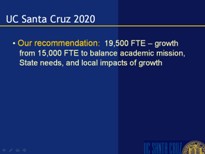 We therefore recommend to you today the lower alternative—of up to 19,500 students (on-campus, fall/winter/spring average). We believe this proposal best balances the academic needs and mission of the campus with responsible development.
We therefore recommend to you today the lower alternative—of up to 19,500 students (on-campus, fall/winter/spring average). We believe this proposal best balances the academic needs and mission of the campus with responsible development.
This will allow the campus to move toward its academic objectives and maintain UCSC’s commitment to deliver an excellent, yet accessible, education to California's next generation of students.
Now, I would like to introduce Frank Zwart who will review the campus record of responsible planning with respect to land-use; provide an overview of 2005 LRDP land use plan; and outline the LRDP environmental impacts and the campus’s record of mitigations in response to community concerns.
Frank enrolled as an undergraduate at UC Santa Cruz (Cowell College) in September 1967, the campus's third year, and graduated in 1971 with a BA in mathematics. He received a Master's in Architecture from Princeton, returned to Santa Cruz in 1977 as an architect and joined UCSC's Office of Physical Planning and Construction in May 1985, and has been campus architect since August 1988.
Frank Zwart, Associate Vice Chancellor,
Physical Planning & Construction/Campus Architect
Santa Cruz campus
Thank you, Chancellor Blumenthal. My presentation has three main topics:
- the public process we developed to update our Long Range Development Plan;
- the Plan’s principles and its land-use plan, growing out of the campus’s tradition of sensitive use of its unique site;
- the LRDP’s environmental review process.
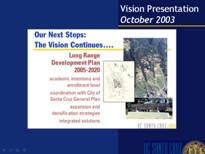 We last spoke with you about UCSC’s campus planning efforts during our Vision Presentation in October 2003. That presentation showed how the campus has met its unique planning challenge: how to fit an innovative and interdisciplinary academic program to a unique and sensitive natural setting. The presentation’s last slide, shown here, set the stage for the upcoming LRDP process.
We last spoke with you about UCSC’s campus planning efforts during our Vision Presentation in October 2003. That presentation showed how the campus has met its unique planning challenge: how to fit an innovative and interdisciplinary academic program to a unique and sensitive natural setting. The presentation’s last slide, shown here, set the stage for the upcoming LRDP process.
At the time of the presentation, preparatory work on the LRDP had already been underway for several months. During the prior spring, with campus enrollment approaching the 15,000 student level provided for in UCSC’s existing 1988 LRDP, a group of senior faculty and administrators came together as the “Framework for the Future” Task Force to recommend to the Chancellor an organizational structure, process and schedule for updating the LRDP.
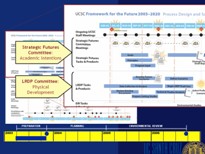 They developed the detailed “road map,” shown here, that described the process in some detail. It called for academic and physical planning efforts to inform each other. A Strategic Futures Committee – the faculty-led committee that Chancellor Blumenthal described – reviewed recent academic plans and initiatives, especially those developed during a campus wide strategic planning process during the previous two years. The Committee balanced academic aspirations, potential enrollment demand, and a sustainable growth rate, and recommended an enrollment target to serve as the basis for the LRDP update.
They developed the detailed “road map,” shown here, that described the process in some detail. It called for academic and physical planning efforts to inform each other. A Strategic Futures Committee – the faculty-led committee that Chancellor Blumenthal described – reviewed recent academic plans and initiatives, especially those developed during a campus wide strategic planning process during the previous two years. The Committee balanced academic aspirations, potential enrollment demand, and a sustainable growth rate, and recommended an enrollment target to serve as the basis for the LRDP update.
The LRDP Committee, a broadly representative group that included students, faculty, staff, and alumni and community representatives, directed work on the LRDP, the physical plan needed to achieve the campus’s academic goals. The Task Force knew that the LRDP update would generate considerable community interest, so it specifically programmed extensive outreach and communication. This included community representation on the LRDP Committee, public meetings both on- and off- campus, discussions with public agencies and local jurisdictions, and numerous opportunities for public review and comment.
The LRDP Committee formed the five topic-based work groups shown in this slide. Each group was asked to:
- summarize how its topics were addressed in the existing LRDP;
- describe current conditions;
- identify key issues that the 2005-2020 LRDP should address; and
- suggest possible approaches to those issues.
The work groups shared their findings with each other, with the LRDP consultants, and with the LRDP Committee as a whole, and their findings were posted on the web. One of the five work groups addressed issues of common concern to both the campus and the community. Consisting of five city and five campus representatives, it held 10 meetings, all off campus, inviting interested community members and City staff to attend and join the discussion.
 As work on the LRDP proceeded, a series of public meetings was held both on- and off-campus, where campus representatives and our consultants met with neighborhood groups. Notes and presentations from the meetings were posted on a publicly accessible web site and an e-mail address received public comments, all of which were also posted on the web site.
As work on the LRDP proceeded, a series of public meetings was held both on- and off-campus, where campus representatives and our consultants met with neighborhood groups. Notes and presentations from the meetings were posted on a publicly accessible web site and an e-mail address received public comments, all of which were also posted on the web site.
In March 2004, the Strategic Futures Committee issued a preliminary recommendation for an enrollment target of 21,000, 15% of whom would be graduate or professional students. After further campus discussion, the Committee confirmed its recommendation in June.
 Based on the 21,000 student envelope, planning principles were drafted and several land use options were studied, leading to a preferred approach that formed the basis of the LRDP’s land use plan. Work on the Plan continued during the summer of 2004, and a first draft was presented at a fifth public meeting in October.
Based on the 21,000 student envelope, planning principles were drafted and several land use options were studied, leading to a preferred approach that formed the basis of the LRDP’s land use plan. Work on the Plan continued during the summer of 2004, and a first draft was presented at a fifth public meeting in October.
A revised draft was published in January and became the basis for the Draft Environmental Impact Report. The EIR process began when the campus published a Notice of Preparation and Initial Study on January 27, 2005. This invited comments on what issues the EIR needed to study from public agencies, organizations, and individuals during a 30-day scoping period. Three public scoping meetings were held, two off campus and one on campus.
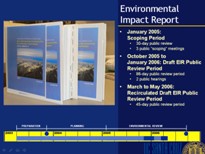 In October the Draft EIR was published, beginning a 63-day public comment period. At the request of the Santa Cruz City Council it was later extended to a total of 86 days. Two public meetings were held to receive comment, one on-campus and one off-campus.
In October the Draft EIR was published, beginning a 63-day public comment period. At the request of the Santa Cruz City Council it was later extended to a total of 86 days. Two public meetings were held to receive comment, one on-campus and one off-campus.
In response to several comments on the Draft EIR, additional traffic analysis was performed for several highway segments and intersections on Highways 1 and 17. This information was recirculated for public comment for 45-days, from March to May. During the two comment periods, 137 letters and e-mails were submitted, and oral comments were received at the two public hearings. All comments received, and responses to them, have been published in the Final EIR.
The most frequent comments concerned the impact of campus growth on housing availability, the water supply, and traffic.
As required by law, the Draft EIR considered project alternatives. After preliminary analysis of ten alternatives, six were rejected as either infeasible or as not meeting project objectives. The four remaining alternatives were evaluated in more detail:
- Satellite Campus at the Former Ft. Ord;
- Reduced Enrollment Growth, to a level of 19,500 students;
- Southerly Expansion land use plan;
- “No Project” alternative, which must always be considered in an EIR.
A Draft EIR is also required to designate, in addition to the “No Project” alternative, another “environmentally superior” alternative. For the 2005 LRDP Draft EIR, the “Reduced Enrollment Growth” alternative was so designated.
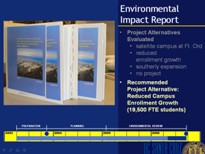 As work on the Final EIR proceeded, and mindful of the potential local impacts of a 21,000 student enrollment, the campus determined that the 19,500 student enrollment level proposed in the Reduced Enrollment Growth alternative would strike an appropriate balance between the campus’s academic intentions and the potential impacts of resulting campus growth on the community. This would represent a 22% reduction in the amount of new growth from the EIR’s baseline year of 2004-05 through 2020.
As work on the Final EIR proceeded, and mindful of the potential local impacts of a 21,000 student enrollment, the campus determined that the 19,500 student enrollment level proposed in the Reduced Enrollment Growth alternative would strike an appropriate balance between the campus’s academic intentions and the potential impacts of resulting campus growth on the community. This would represent a 22% reduction in the amount of new growth from the EIR’s baseline year of 2004-05 through 2020.
This is the alternative that is analyzed in the Final EIR and that we are asking The Regents to adopt today.
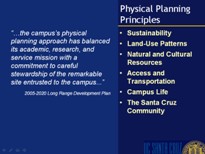 I would like to turn now to the plan itself and its physical planning principles, intended to balance the University’s academic, research, and service missions with its commitment to site stewardship. The principles are grouped into six categories, each growing out of practices that have helped define UC Santa Cruz.
I would like to turn now to the plan itself and its physical planning principles, intended to balance the University’s academic, research, and service missions with its commitment to site stewardship. The principles are grouped into six categories, each growing out of practices that have helped define UC Santa Cruz.
The first, and overarching, principle is sustainability. Surrounded on three sides by parklands and on the fourth side by the City of Santa Cruz, the campus forms only one part of a much wider environment. Campus planning and operations must respect that framework, meeting the needs of today’s users while preserving the ability of future users to meet theirs.
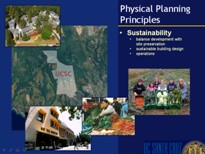 We will develop our site thoughtfully, balancing necessary construction with site preservation, illustrated here by the Colleges Nine and Ten residential complex completed in 2002. Buildings will be designed with sustainable features, like minimizing use of air conditioning and using the sunscreens, as on the new Bay Tree Bookstore. Sustainable practices extend into campus operations. For example, the Campus Food Systems Working Group works to bring sustainable food to campus dining hall tables. During 2005-06, over 21% of produce served in the dining halls was organic, from farms within 250 miles of the campus.
We will develop our site thoughtfully, balancing necessary construction with site preservation, illustrated here by the Colleges Nine and Ten residential complex completed in 2002. Buildings will be designed with sustainable features, like minimizing use of air conditioning and using the sunscreens, as on the new Bay Tree Bookstore. Sustainable practices extend into campus operations. For example, the Campus Food Systems Working Group works to bring sustainable food to campus dining hall tables. During 2005-06, over 21% of produce served in the dining halls was organic, from farms within 250 miles of the campus.
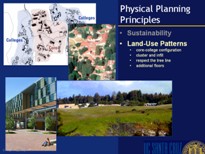 The land-use pattern principles call for the well-established core-college configuration to continue. Large scale specialized facilities – laboratories, libraries, art and performance spaces, and the like – are surrounded by interdisciplinary residential colleges.
The land-use pattern principles call for the well-established core-college configuration to continue. Large scale specialized facilities – laboratories, libraries, art and performance spaces, and the like – are surrounded by interdisciplinary residential colleges.
Infilling developed areas and clustering buildings to create courtyards and public spaces will continue, exemplified here by UCSC’s first two colleges, Cowell and Stevenson. The LRDP calls for 65% of projected new space to be built within the currently developed campus.
UCSC’s buildings have always been designed to be lower than the surrounding tree canopy, and this will continue. Opportunities to build taller to conserve land will be pursued when a building’s program and site permit it, as occurred two years ago with Engineering Building 2.
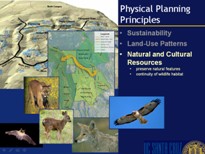 The natural and cultural resources of the campus will be preserved and protected. The LRDP’s land use map takes terrain and vegetation into account; buildings will be sited and designed to do the same. A variety of plant and animal species inhabits the campus and surrounding parklands. The land use map maintains the continuity of their habitat. Storm water runoff leaves the campus through a complex hydrological system of ravines and drainages, both above and below ground. Careful storm water management will keep this system in balance and prevent slope erosion.
The natural and cultural resources of the campus will be preserved and protected. The LRDP’s land use map takes terrain and vegetation into account; buildings will be sited and designed to do the same. A variety of plant and animal species inhabits the campus and surrounding parklands. The land use map maintains the continuity of their habitat. Storm water runoff leaves the campus through a complex hydrological system of ravines and drainages, both above and below ground. Careful storm water management will keep this system in balance and prevent slope erosion.
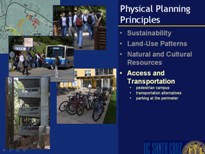 Our principal goal in knitting together a large and topographically complex campus is to create an integrated transportation network that promotes pedestrian use and enjoyment of the campus. Studies of walking time into the north campus were examined as the LRDP’s land use map was developed. Alternatives to single-occupant motor vehicles – like bicycles and shuttles – will be encouraged and parking areas will be located at the perimeter of the developed campus.
Our principal goal in knitting together a large and topographically complex campus is to create an integrated transportation network that promotes pedestrian use and enjoyment of the campus. Studies of walking time into the north campus were examined as the LRDP’s land use map was developed. Alternatives to single-occupant motor vehicles – like bicycles and shuttles – will be encouraged and parking areas will be located at the perimeter of the developed campus.
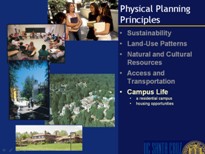 UC Santa Cruz has always been a residential campus, where the students’ classroom learning continues within its ten interdisciplinary colleges. The LRDP creates housing opportunities for students, faculty and staff, with land area designated to provide housing for 50% of undergraduates, 25% of graduate students, 25% of faculty, and 3% of staff.
UC Santa Cruz has always been a residential campus, where the students’ classroom learning continues within its ten interdisciplinary colleges. The LRDP creates housing opportunities for students, faculty and staff, with land area designated to provide housing for 50% of undergraduates, 25% of graduate students, 25% of faculty, and 3% of staff.
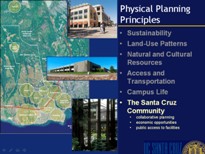 The LRDP also recognizes the role of the campus in the local community, its effects on Santa Cruz neighborhoods, shown here in relation to the campus, and the importance of ongoing communication and cooperation. Collaborative planning, exemplified here by the University Town Center, a third-party development in downtown Santa Cruz, can result in benefits for both town and gown. The campus will also work with local jurisdictions on joint economic development projects. UCSC assisted the City’s Redevelopment Agency in securing a Federal grant to explore the potential for a technology transfer center at 2300 Delaware Avenue, a former chip-fabrication facility about two miles south of the campus that was recently acquired by the campus in a gift/purchase transaction. The campus will also continue to provide opportunities for members of the public to use its many resources, like the Science and Engineering Library.
The LRDP also recognizes the role of the campus in the local community, its effects on Santa Cruz neighborhoods, shown here in relation to the campus, and the importance of ongoing communication and cooperation. Collaborative planning, exemplified here by the University Town Center, a third-party development in downtown Santa Cruz, can result in benefits for both town and gown. The campus will also work with local jurisdictions on joint economic development projects. UCSC assisted the City’s Redevelopment Agency in securing a Federal grant to explore the potential for a technology transfer center at 2300 Delaware Avenue, a former chip-fabrication facility about two miles south of the campus that was recently acquired by the campus in a gift/purchase transaction. The campus will also continue to provide opportunities for members of the public to use its many resources, like the Science and Engineering Library.
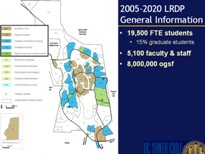 The land use plan included in the LRDP is based on a projected student enrollment of 19,500 in 2020, 15% of whom would be graduate students. This generates a faculty and staff size of 5,100 and up to 8,000,000 gross square feet of building area.
The land use plan included in the LRDP is based on a projected student enrollment of 19,500 in 2020, 15% of whom would be graduate students. This generates a faculty and staff size of 5,100 and up to 8,000,000 gross square feet of building area.
Developable areas are concentrated at the center of campus lands and adjacent to the campus’s main entrance. This will include the land use designations for instruction and research space, and academic, student, and public support functions, in areas shown in brown on the plan. (This designation is also applied to the 2300 Delaware site.) Residential colleges and housing – in the blue areas – and physical recreation and education space – in the green areas – surround the academic core.
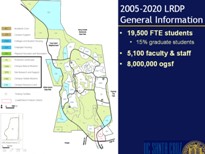 Open space areas on campus fall into four land use categories:
Open space areas on campus fall into four land use categories:
- the Campus Natural Reserve protects 410 acres of land for teaching and research;
- Protected Landscape maintains certain lands for their wildlife habitat and scenic value;
- Site Research and Support contains the Arboretum and Center for Agroecology and Sustainable Food Systems farm and garden;
- the Campus Habitat Reserve preserves habitat for two endangered species: the California red-legged frog and the Ohlone tiger beetle.
Campus Resource Land is the designation reserved for land not planned for development under this LRDP.
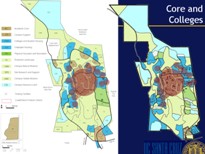 This land use plan results from a number of thoughtful adjustments to the current 1988 LRDP plan, shown on the right and fondly referred to on campus as the “lava lamp.” We can transform plan’s colors into those used in the revised plan in order to compare the two. Their basic outlines are identical: Both maintain the academic core, with colleges and housing surrounding it.
This land use plan results from a number of thoughtful adjustments to the current 1988 LRDP plan, shown on the right and fondly referred to on campus as the “lava lamp.” We can transform plan’s colors into those used in the revised plan in order to compare the two. Their basic outlines are identical: Both maintain the academic core, with colleges and housing surrounding it.
 The broad meadows in the southern part of the campus remain as open space.
The broad meadows in the southern part of the campus remain as open space.
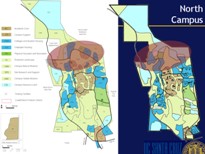 Both propose development of the north campus, each having a loop road and bridge to Empire Grade to the west.
Both propose development of the north campus, each having a loop road and bridge to Empire Grade to the west.
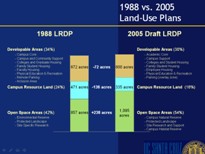 The land use boundary adjustments reflect the anticipated need for additional core academic space, and all were based on recent environmental studies of the biota, geology, and hydrology in the areas involved. In all, by balancing infill and expansion, this plan increases protected open space areas from 857 to 1,095 acres.
The land use boundary adjustments reflect the anticipated need for additional core academic space, and all were based on recent environmental studies of the biota, geology, and hydrology in the areas involved. In all, by balancing infill and expansion, this plan increases protected open space areas from 857 to 1,095 acres.
Before turning to the Environmental Impact Report prepared for this LRDP update, I would like to pause for a moment to review the campus’s mitigation track record under the 1988 LRDP EIR. That document proposed 30 on-campus mitigations, and eight “LRDP-level” mitigations were added in subsequent project EIRs.
 Of those 38, 33 have been fully implemented, and the remaining five have been at least partially implemented. Of these, the most challenging have been the ambitious housing goals, which committed the campus to strive to house “70 percent of undergraduate students, 50% of graduate students..., 25% of faculty members, and 50% of new staff members recruited from outside Santa Cruz County [in University-sponsored housing], subject to financial feasibility.” Although that has not proved to be financially viable, the campus has added well over 2,000 student beds during that time, and has housed an average of 48% of undergraduates, 25% of graduate students, and 30% of faculty.
Of those 38, 33 have been fully implemented, and the remaining five have been at least partially implemented. Of these, the most challenging have been the ambitious housing goals, which committed the campus to strive to house “70 percent of undergraduate students, 50% of graduate students..., 25% of faculty members, and 50% of new staff members recruited from outside Santa Cruz County [in University-sponsored housing], subject to financial feasibility.” Although that has not proved to be financially viable, the campus has added well over 2,000 student beds during that time, and has housed an average of 48% of undergraduates, 25% of graduate students, and 30% of faculty.
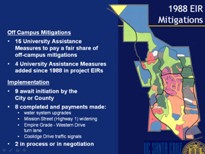 For off-campus mitigations, the campus adopted 15 University Assistance Measures, or UAMs, to make a “fair share” financial contribution to local agencies and jurisdictions responsible for the implementation of certain mitigations. Subsequent project EIRs added another four UAMs. Of those 19, nine await initiation by the City or County, eight have been completed and paid for, and two remain in process or in negotiation.
For off-campus mitigations, the campus adopted 15 University Assistance Measures, or UAMs, to make a “fair share” financial contribution to local agencies and jurisdictions responsible for the implementation of certain mitigations. Subsequent project EIRs added another four UAMs. Of those 19, nine await initiation by the City or County, eight have been completed and paid for, and two remain in process or in negotiation.
Turning now to the Final Environmental Impact Report for this project, it analyzes the 2005-2020 Long Range Development Plan, as revised to reflect the “Reduced Enrollment Growth” alternative of 19,500 students presented in the Draft EIR.
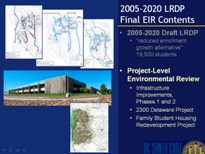 The Final EIR document also includes project level analysis for three campus projects:
The Final EIR document also includes project level analysis for three campus projects:
- an infrastructure project to renew the campus’s storm water conveyance system, and its water, heating, cooling, electrical, and natural gas distribution systems;
- build out for full occupancy of the former chip fabrication plant at 2300 Delaware;
- a proposed project that will replace 199 units of Family Student Housing with about 400 units.
The infrastructure and 2300 Delaware projects will be presented to the Chancellor and the Family Student Housing Redevelopment project will return for Regental design approval when schematic design is complete.
The Final EIR identifies 45 impacts as “significant” or “potentially significant.” Mitigation measures have been proposed to reduce ththem to “less than significant,” leaving 11 that are categorized as “significant and unavoidable.” Because mitigations for many of these 11 are the responsibility of jurisdictions other than the University, CEQA requires that they be classified as “significant and unavoidable.”
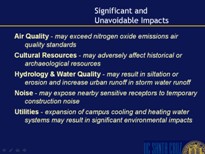 The EIR identifies a handful of significant and unavoidable impacts, in the areas of air quality, cultural resources, hydrology and water quality, temporary construction noise, and utilities.
The EIR identifies a handful of significant and unavoidable impacts, in the areas of air quality, cultural resources, hydrology and water quality, temporary construction noise, and utilities.
In discussing public comment on the Draft EIR earlier, I mentioned particular concerns about traffic, housing, and water. I would like to review those in more detail, and to discuss some of the strengthened mitigation measures proposed in the Final EIR.
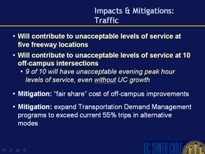 The Final EIR’s traffic analysis projects that campus growth, along with other cumulative growth in the area, would contribute to unacceptable levels of service at five freeway locations and to unacceptable levels of service at 10 off-campus intersections. (To set the context of this finding, nine of these ten intersections will have unacceptable evening peak hour levels of service, even without UCSC growth.)
The Final EIR’s traffic analysis projects that campus growth, along with other cumulative growth in the area, would contribute to unacceptable levels of service at five freeway locations and to unacceptable levels of service at 10 off-campus intersections. (To set the context of this finding, nine of these ten intersections will have unacceptable evening peak hour levels of service, even without UCSC growth.)
To mitigate traffic impacts, UCSC has committed to funding its “fair share” cost of off-campus improvements, and to expand its Transportation Demand Management (or TDM) programs. UCSC’s TDM programs have been extremely effective. The 1988 LRDP EIR set a target of 40% of trips to campus in other than single occupant motor vehicles. The current campus rate is 55%, and we intend to exceed that.
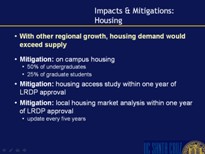 Projected campus growth, combined with other growth in the region, would result in a housing demand exceeding anticipated supply. As mitigations, the campus will:
Projected campus growth, combined with other growth in the region, would result in a housing demand exceeding anticipated supply. As mitigations, the campus will:
- make sufficient University housing available to meet the LRDP housing goals of 50% of undergraduates and 25% of graduate students;
- fund and carry out a study of ways in which the University can collaborate with other large employers and the City and County to assist in providing wider access to housing for UCSC employees and affiliates and other community members;
- fund and carry out a local housing market analysis to assist the University, the City, and the County in planning potential joint projects.
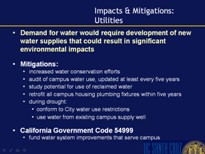 As of 2003, UC Santa Cruz used only about 5% of all the water supplied by the City of Santa Cruz Water Department. Nevertheless, when combined with other regional growth, campus growth will increase the demand for water, likely requiring development of new water supplies that could have significant environmental impacts.
As of 2003, UC Santa Cruz used only about 5% of all the water supplied by the City of Santa Cruz Water Department. Nevertheless, when combined with other regional growth, campus growth will increase the demand for water, likely requiring development of new water supplies that could have significant environmental impacts.
The campus has an excellent record of water conservation. UCSC’s water use in 2002 was only 3.5% greater than in 1986-87, despite increasing our enrollment by 52% and adding nearly 2,000,000 square feet of building. The campus proposes mitigations to strengthen its conservation efforts further, and will conduct a regular audit of campus water use to help focus those efforts. Plumbing fixtures in University housing will be retrofitted to the most recent water conservation standards, and the potential for reclaimed water use will be investigated. During periods of drought, the campus will conform to City water use restrictions and may also use water from an existing campus well. We will also meet the requirements of State Government Code 54999 by funding those portions of water system improvements that serve the campus.
To conclude, I would like recall what the campus’s first Long Range Development Plan cited as its “primary concern” back in September 1963:
“…the arrangement on a remarkable campus site of the activities and facilities that grow out of the educational program….
It went on to say that:
“…the site itself must be utilized so sympathetically that its natural aesthetic qualities are preserved, and remain to assist and enhance the development of the academic goals.”
Over 40 years later, those intentions have been confirmed, and will be continued by the 2005-2020 LRDP.
I am happy now to return the microphone to Chancellor Blumenthal for some closing comments.
George Blumenthal, Acting Chancellor
Santa Cruz campus
As a faculty member, I was attracted to UC Santa Cruz 34 years ago by its world-class astronomy and astrophysics department which had moved from the Lick Observatory mountaintop to UCSC when the campus opened in 1965. Today, I am particularly proud to report that there are other notable home grown programs at UCSC. As you have heard, we now have nationally- and world-recognized programs in each of our academic divisions. It is important that our other academic programs—including emerging disciplines—have that same opportunity for distinction.
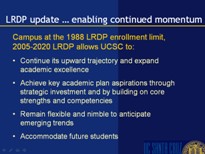 The campus is currently at the enrollment limit defined by its 1988 LRDP. We believe that allowing us to add 4,500 students by the year 2020 will allow UC Santa Cruz to:
The campus is currently at the enrollment limit defined by its 1988 LRDP. We believe that allowing us to add 4,500 students by the year 2020 will allow UC Santa Cruz to:
- Continue its upward trajectory;
- Achieve our key academic aspirations;
- Remain flexible and nimble; and
- Accommodate demand from future students in California.
Today, you’ve heard a lot about buildings and plans, impacts and mitigations. I want to remind everyone, that we’re really talking today about people and the State’s responsibility to future generations.

